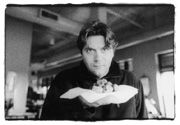Truffles, like caviar and walk-in closets, serve as a powerful argument that being rich really is better. They’re in season right now and no one does these elusive fungal treasures like Scott Carsberg, the disputatious minimalist chef/genius at Lampreia (2400 First, 443-3301), that stark Belltown monument to gastronomic innovation. For those who have never tasted these miraculous mushrooms, the experience is nearly indescribable: When eating a truffle, first comes the fragrance, then the rich, subtle flavor, and then the hyperbole begins. They taste like sex smells, or maybe even better. “It’s euphoria,” Carsberg professes. Simply put, if you’re giving yourself a gift this holiday season, a pilgrimage to Lampreia should be in the running.
Carsberg, who has lived and cooked in the Italian Piedmont region where truffles are found, makes the white truffle—tartufi bianchi—the gastronomic centerpiece of his menus every autumn. They are the cr譥 de la cr譥 of the underground tubers, even more highly prized than the French black P鲩gords—with the price tag to prove it. Truffles won’t be descending to a price within reach of people who shop the sales in supermarkets. Known as the “white diamonds of Piedmont” because of their superior fragrance and scarcity, they’re nearly as expensive as diamonds. Carsberg is paying $1,600, up $400 a pound because this year they’re scarcer than usual.
There have been some less than satisfying attempts at cultivating truffles, but producing them is more luck than anything. Since they grow underground, the first problem is finding them, the second is to ease them out of the ground without disturbing the mycelium or allowing them to give birth to truffle-babies. Most truffles grow well beneath the soil, often as deep as a foot; less often does one break the soil. The tubers are usually found with the help of a scruffy mongrel bitch, whose worth by weight corresponds roughly with the truffles she finds. Truffle-hunters have also used water-witching wands, pigs, and goats; Russians reportedly have even recruited bear cubs. Certain species of flies lay their eggs in truffles, so to the skilled observer, the presence of flies batting around is a valuable clue.
Truffles, especially in Italy, are hunted at night. This is said to be because the odor is stronger then, but there’s another reason: to cover their exact location. As in local mushroom hunts for wild morels or boleti, poachers are always lurking, drawn to their spongy prey by the large sums of money involved. Digging is done with the aid of a small flashlight, which hopefully won’t shine enough light to guide a truffle pirate to the treasure trove.
As is common with expensive foods, fraud is traditionally rampant in the truffle market. At the first level—digger to wholesaler—tunnels bored by insects are sometimes filled with clay. For foreign markets, where there’s less familiarity with this tuber, gray truffles are sometimes dyed black by the wholesaler to look like the prized P鲩gord.
Carsberg buys the dirty-looking white lumps, which are a little smaller than golf balls, from a dentist named Mimo who hunts them, presumably, between root canals. In the dark of night the DDS trifolau and his female mutt sniff out the subterranean fungi, which barely bulge through the surface of the rich clay soil near the roots of scrub oaks in Italy’s hilly region. Thankfully, these truffles find their way to Lampreia’s kitchen, where I recently made my autumnal trek to sample one of Carsberg’s fabulous tartufi menus.
Before things got started, Carsberg sent us a tempura-ed pumpkin blossom in a puddle of smoky creamy salmon sauce that shows what he’s famous for. It’s an edible flower that really tastes like the vegetable from which it comes. The texture has a dense, winter-squash quality, lightened up by a quick, clean fry in crisp transparent batter. Even after cooking, the yellow flower is bright and the green of the tendrils looks like it’s about to wrap itself around a stake.
Then the parade of tartufi dishes began. White truffles are never cooked, but shaved paper thin over the food moments before the dish is served. First, Carsberg served a grilled porcini in a creamy fonduta sauce of reggiano cheese with white truffle shaved over the top. Next came a tartar of hand-chopped venison glistening with olive oil, a sprinkling of beet, and celery sprouts—again, with the flavorful tartufi in slivers on top. The meat is cut fine enough to spread and has a bit of a gamey twang. Spiritually, we were OK with it—this deer was obviously born to lay down on a plate with these elegant fungi that seemed to have, with this gathering of clean flavors, overtones of garlic and cheese.
Then Carsberg delivered a puree of cranberry beans, a smooth bean soup, topped with shaved truffles. So far, every dish remained true to his philosophy of putting these mighty ‘shrooms with humble ingredients to add “a touch of luxury,” as he says.
A couple passing by my table questioned Carsberg about the stainless-steel truffle plane he uses to shave the fungi, asking disapprovingly, “Yours isn’t cherry wood?” Carsberg muttered something inaudible but disparaging into his chef’s coat, dismissing the subject and showing a kind of restraint he’s not known for. He doesn’t have to prove a thing—chefs always have the upper hand with foodies who thrive on tool envy, one-upmanship, and earnest angels-dancing-on-the-head-of-a-pinenut discussions. Besides, having a couple pounds of truffles in your fridge trumps any kind of pretentious foodie bragging.
For entrees my dinner partner and I shared plates of tortelloni, tiny pasta baskets filled with pumpkin, and tagliatelle, a strand pasta a little smaller than fettuccini sauced with brown butter. Again, Carsberg shaved the truffles over these dishes, I swooned and ate every bite with accompanying slurps of 1996 Paitin Langhe, whose celebrated nebbiolo grapes come from the same ground as the tartufi.
The truffle season lasts approximately from late October until February. The black P鲩gords are just starting now and need a little more cooking than their paler cousins to bring out the flavor. Carsberg saut饳 them to crush with a steamed Finn potato, cooks them in a little butter with scallops, or layers them over a piece of fresh fish.
If you love food and have never had a truffle, there’s a major gastronomical deficit in your life. This holiday season, do what you have to do—narrow down your gift list, pull your kid out of college, or refinance your house—Scott Carsberg is taking reservations.
Michael Hood is a freelance writer and regular contributor to Seattle Weekly.








